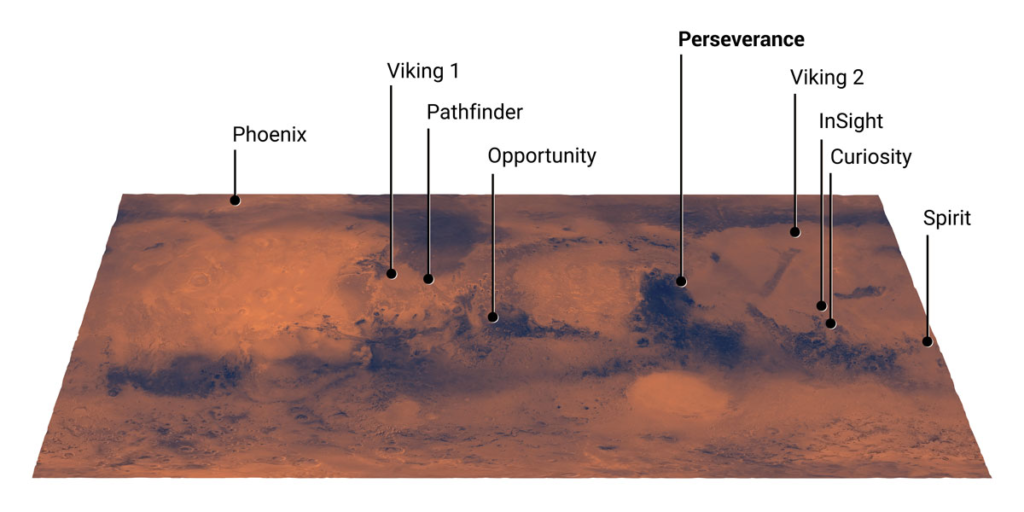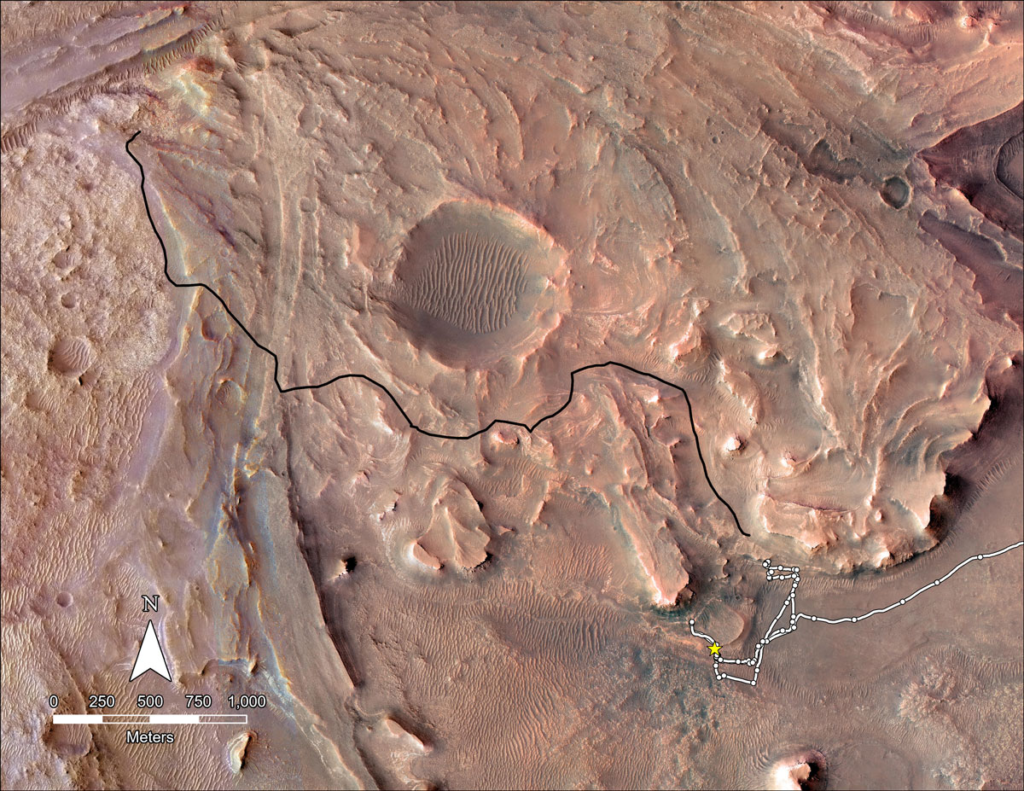
NASA’s Perseverance Rover Continues To Discover New Territory
NASA’s Perseverance Rover has been staying very busy on the Martian surface as it makes its way to new territory. With the help of Ingenuity, the two have been making impressive progress and some fascinating discoveries. This includes dust devils, unique rock structures, and evidence of water from the past, just to name a few.
At the same time, the rover is also collecting samples as it goes in preparation for the Mars Sample Return mission which is being prepared. The rover is currently almost 10 kilometers from its original landing site after heading far northwest. NASA originally put a lot of time into picking the landing site based on its features and the surrounding area.
That work is now paying off as Perseverance goes further into the unknown. Here I will go more in-depth into the rover’s recent discoveries, the path it has taken, what’s next, and more.
Signs of Water

In early 2021, the car-sized Perseverance rover landed in the Jezero Crater. NASA chose Jezero Crater as the landing site for the rover because scientists believed the area was once flooded with water and was home to an ancient river delta. More specifically, Jezero Crater tells a story of the on-again, off-again nature of the wet past of Mars. More than 3.5 billion years ago, river channels spilled over the crater wall and created a lake. Scientists see evidence that water carried clay minerals from the surrounding area into the crater lake. Conceivably, microbial life could have lived in Jezero during one or more of these wet times. If so, signs of their remains might be found in lakebed or shoreline sediments. Scientists will study how the region formed and evolved, seek signs of past life, and collect samples of Mars rock and soil that might preserve these signs. Here you can see Perserverance’s landing location relative to other Mars missions. This specific spot was untouched and the perfect place to land a modern rover and helicopter.
Recently, we got some new evidence of the planet’s past when Perseverance came in contact with a special type of mineral. In this case, last month in September, NASA said that the Mars 2020 scientists were buzzing with excitement as Perseverance made its final approach towards a special rock unit that played a pivotal role in selecting Jezero as the landing site for exploration. Located in a narrow band along the inner edge of Jezero’s western crater rim, this layer showcases pronounced signatures of a mineral known as carbonate.
They went on to clarify, “On Earth, carbonates typically form in the shallow shoals of freshwater or alkaline lakes. It’s hypothesized that this might be the case for the margin carbonate unit on Mars too—over 3 billion years ago, the waters of a lake in Jezero crater might have lapped against its shores, depositing this carbonate layer. An alternative hypothesis is that the carbonates formed through mineral carbonation, where silicate minerals (like olivine) react with CO₂ and are converted to carbonates” they said.
This new information joins a host of other evidence that this rover and other science missions have found. For example earlier this year, Perseverance may have found signs of what was once a rollicking river on Mars, one that was deeper and faster-moving than scientists have ever seen evidence for in the past. The river was part of a network of waterways that flowed into Jezero Crater, the area the rover has been exploring since landing more than two years ago. Looking at the image, scientists think that these bands of rocks may have been formed by a very fast, deep river – the first of its kind evidence has been found on Mars.
The agency said in a statement, “When viewed from the ground, the curved layers appear arranged in rows that ripple out across the landscape. They could be the remnants of a river’s banks that shifted over time – or the remnants of sandbars that formed in the river. The layers were likely much taller in the past. Scientists suspect that after these piles of sediment turned to rock, they were sandblasted by wind over the eons and carved down to their present size” they said. With this in mind, the rover’s collected samples are set to return to Earth by the mid-2030s. However, in that time period, a lot of milestones need to be completed from landing another vehicle on the surface of Mars, launching the first rocket off the red planet, and returning home.
A Changing Route

Perseverance and Ingenuity have taken quite the path to get to where they are now. In relation to each other, Ingenuity is ahead after completing its 63rd flight. This continued partnership between the two spacecraft has helped tremendously as mission planners and scientists pick exact paths and locations to head to based on helicopter images and data. In return, we have seen a lot of unique discoveries beyond just signs of past water.
Just a few weeks ago for example, NASA’s Perseverance rover captured a Martian dust devil moving east to west at a clip of about 12 mph (19 kph) along “Thorofare Ridge” on Aug. 30. The video, which was sped up 20 times, is composed of 21 frames taken four seconds apart. It was enhanced in order to show maximal detail. Much weaker and generally smaller than Earth’s tornadoes, dust devils are one of the mechanisms that move and redistribute dust around Mars. Scientists study them to better understand the Martian atmosphere and improve their weather models.
In a statement, the agency said, “Using data from the imagery, mission scientists determined that this particular dust devil was about 2.5 miles (4 kilometers) away. They calculated its width to be about 200 feet (60 meters). And while only the bottom 387 feet (118 meters) of the swirling vortex are visible in the camera frame, the scientists could also estimate its full height. “We don’t see the top of the dust devil, but the shadow it throws gives us a good indication of its height,” said Mark Lemmon, a planetary scientist at the Space Science Institute in Boulder, Colorado, and a member of the Perseverance science team. “Most are vertical columns. If this dust devil were configured that way, its shadow would indicate it is about 1.2 miles (2 kilometers) in height” he said.
This was spotted on Perseverance’s path to a specific science location. This future destination is a location named “Jurabi Point” that NASA scientists have been eagerly waiting to explore even before landing. The distance between the Rover’s current position and the point is about 1 kilometer. As far as why this location is so important, its what geologists call a ‘triple-junction’: a place where three geologic units meet. Specifically, it’s where the boulder-rich unit, upper fan sedimentary rock, and margin unit intersect. Exploring the contacts between these three units will help the agency clarify their age relationships, whilst also giving them another chance to study and possibly sample a boulder. Interestingly, back in August the rover tried getting a sample of a similar rock but it was too hard. This is why NASA is hoping for a second chance in the near future.
Focusing back on the path the rover and helicopter have taken, what’s so interesting is how it changes based on the terrain and what they see. Back in December 2022, NASA released a map showing the planned route NASA’s Perseverance Mars rover would take across the top of Jezero Crater’s delta in 2023. Compare that to the up-to-date map showing the exact path taken, and you can see quite a few discrepancies as alterations. For example, the rover took a right and went much closer to the massive Belva crater before turning left. This has to do with the fact that the agency has only so much data on exact planet features and terrain. However, once Perseverance and Ingenuity are up close and personal with different paths, they can then choose the best option and go that way.
Also, as partially mentioned prior, a key objective for Perseverance’s mission on Mars is astrobiology, including the search for signs of ancient microbial life. The rover will characterize the planet’s geology and past climate, pave the way for human exploration of the Red Planet, and be the first mission to collect and cache Martian rock and regolith (broken rock and dust). Subsequent NASA missions, in cooperation with ESA (European Space Agency), would send spacecraft to Mars to collect these sealed samples from the surface and return them to Earth for in-depth analysis. In the grand scheme of things, the Mars 2020 Perseverance mission is part of NASA’s Moon to Mars exploration approach, which includes Artemis missions to the Moon that will help prepare for human exploration of the Red Planet.
In terms of what to expect in the future, NASA said, “Once we’ve completed our study at the triple-junction, we then plan on heading west, documenting changes in the margin unit as we drive uphill. We’ll conclude the Margin Campaign by driving down into the valley for the first time – the river channel which feeds the western fan – in order to investigate an enigmatic light-toned rock unit exposed within the channel wall. Something we can look forward to hearing more about in the next few months.
Conclusion
NASA’s Perseverance Rover and Ingenuity Helicopter have been very busy over the last few months. They have had quite a few new discoveries relating to past water, dust devils, and much more. The rover has also kept up with sample collection for the eventual return to Earth. We will have to wait and see how it progresses and the impact it has on the space industry.
